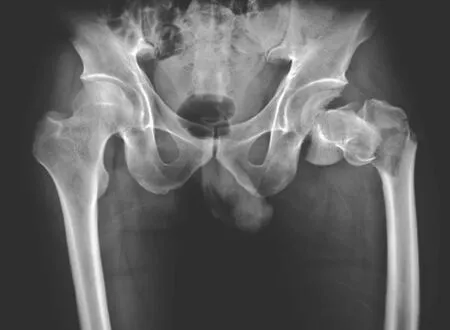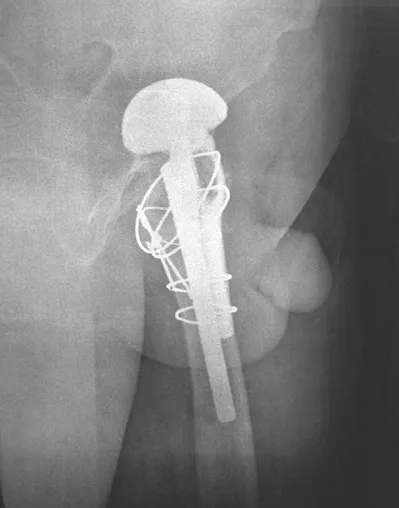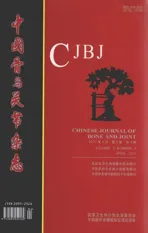大粗隆爪钢板结合全髋关节置换术治疗陈旧性股骨粗隆间骨折 12 例中期随访报告
2016-06-17姜旭徐辉
姜旭 徐辉
大粗隆爪钢板结合全髋关节置换术治疗陈旧性股骨粗隆间骨折 12 例中期随访报告
姜旭 徐辉
【摘要】目的 报告大粗隆爪钢板结合全髋关节置换术(total hip arthroplasty,THA)治疗陈旧性股骨粗隆间骨折的中期随访结果。方法 回顾性分析 2005年至2012年,治疗失败的 12 例(12 髋)股骨粗隆间骨折患者人工全髋关节置换术结合爪钢板重建大粗隆骨不连的临床疗效。10 例(10 髋)随访 24~81 个月,平均 42.7 个月。关节置换术时的患者平均年龄为 62.3(41~80)岁。临床疗效以 Harris 评分、X 线片进行评价。结果 末次随访时髋关节 Harris 评分平均 87.3(75~94)分,与术前平均 17.4(6~38)分比较,差异有统计学意义(P<0.001)。末次随访时3 例存在大粗隆部位疼痛,4例残留患肢跛行。9 例大粗隆骨不连均获得骨性愈合,1例为纤维愈合。未见钢板移位和钢缆断裂。并发症包括脱位1例和医源性坐骨神经损伤1例。12 例均无需翻修。结论 对于股骨粗隆间骨折初期治疗失败病例采用 THA 结合爪钢板重建大粗隆骨不连中期临床疗效较为满意。
【关键词】关节成形术,置换,髋;股骨;骨折;骨折固定术,内;大粗隆
股骨粗隆间骨折(intertrochanteric fracture)约占全部髋关节骨折的 50%[1]。由于股骨粗隆间骨质血运良好,极少发生不愈合,初期治疗首选手术内固定治疗。股骨粗隆间骨折内固定失败率为3%~12%[2-4]。对预计再次内固定手术失败几率较高者、继发明显临床症状的创伤性关节炎或股骨头缺血性坏死者[5-7]可考虑行全髋关节置换术(total hip arthroplasty,THA)。
对于合并大粗隆骨不连的陈旧性股骨粗隆间骨折病例,大粗隆的骨性重建是手术的重点和难点。近年来,爪钢板在复杂初次 THA 以及髋关节翻修术[8-12]中的应用取得了良好的疗效。2005年至2012年,我院为 12 例(12 髋)陈旧性股骨粗隆间骨折患者行大粗隆爪钢板结合 THA 治疗,取得满意的中期疗效,现报告如下。
资料与方法
一、一般资料
本组 12 例(12 髋)中,男 7 例,女3 例,均为单侧关节置换。左右侧各 5例。患者平均体质量指数(BMI)为 26.3(19.2~30.2)。Charnley 分型结果如下:A 型8例,B 型和 C 型各1例。骨折原因:摔伤 7 例,车祸伤3 例。首期保守治疗者 5例,手术治疗者 5例。从骨折至行 THA 时间为 9~240 个月,平均 36.5个月。
末次随访时1例死于脑血管意外,1例失随访,其余 10 例(10 髋)随访 24~81 个月,平均42.7 个月。
二、手术方法
THA 手术指征为骨折不愈合且预计再次内固定手术失败几率较高者。术前影像学检查提示存在大粗隆骨不连,并经术中所见证实。股骨侧骨缺损依据 Paprosky 系统[13]分型如下:II型 6 例、IIIa 型2例、IIIb 型 2例。术前 12 例均血沉、C 反应蛋白和影像学检查排除髋关节活动性感染之可能。
12 例均采用后外侧入路。既往内固定物予全部取出。髋臼侧均使用非骨水泥型假体。股骨侧重建也均使用非骨水泥型柄,其中 4髋采用标准柄长近端固定柄,2髋采用单体加长广泛涂层柄(Depuy公司 Solution 假体),4髋采用加长组配式股骨柄(Link 公司 MP 假体)。全部病例均使用 Zimmer 公司Cable-Ready 钢缆钢板系统固定大粗隆骨不连,并取自体股骨头的碎屑松质骨填充大粗隆骨块与钢板之间的间隙。
股骨头直径 7 髋为 28 mm,3 髋为 32 mm。关节负重面选择上1髋为陶瓷-陶瓷关节面,2髋为陶瓷-聚乙烯关节面,其余 7 髋为金属-聚乙烯关节面。
术后第2天允许患者扶拐下地,患肢严格免负重至术后 6 周,并避免髋关节外展肌主动练习。此后患髋逐渐增加负重量,至术后3 个月,开始完全负重,并在康复科医生指导下进行髋关节外展肌力量的锻炼。
三、疗效评价指标
要求全部患者于术后3、6、12、24 个月返院复查。此后每 2年返院复查1次。采用 Harris 评分评价关节功能,包括疼痛、功能状态、畸形及活动度;满分为 100 分,≥90 分为优,~89 分为良,~79 分为可,≤69 分为差。根据 Harris 评分,术后关节疼痛分为 4级:无疼痛、轻度疼痛、中度疼痛、严重疼痛。根据 Harris 评分结果,将术后跛行分为 4级:无跛行、轻度跛行、中度跛行和重度跛行。行患者主观满意度评价,共分为 4级:非常满意、比较满意、不满意和非常不满意。影像学评估主要参考手术前后系列 X 线片。股骨假体周围区域定位分别依据 Gruen 等[14]的七区分法。股骨假体周围透亮带的程度依据 Callaghan 等[15]标准。非骨水泥型柄的固定情况依据 Engh 等[16]标准。大粗隆固定情况依据 Zarin 等[11]标准(即术前游离骨折块与大粗隆主体结构间存在连续性骨小梁,骨折块移位在1cm 以内且未伴有钢板移位和钢缆断裂征象,为出现骨性愈合)。异位骨化(heterotopic ossification,HO)根据 Brooker 标准[17]进行分级。
四、统计学方法
采用 SPSS 15.0 统计软件进行分析。手术前后Harris 评分比较采用配对 t 检验。检验水准 α=0.05。
结 果
一、临床疗效
髋关节 Harris 评分从术前平均 17.4(6~38)分提高末次随访时的 87.3(75~94)分(P<0.001)。2髋评分为优,5髋为良,3 髋为可。术后3 例在活动后出现大粗隆区轻度疼痛,休息后可缓解。末次随访时 5例患者的髋关节外展肌肌力达到 5级,3 例为 4级,2例为3 级。4例残留轻度跛行,均为外展肌肌力为3 级(2例)和 4级(2例)者。2例对手术疗效较不满意,跛行(1例)和活动度差(1例),其余 10 例表示非常满意或比较满意。
二、影像学评价
根据 Engh 等的标准,股骨柄9例发生骨长入,1例为稳定的纤维固定,未见股骨柄松动、下沉及周围骨溶解征象。大粗隆骨不连有9髋获得骨性愈合,仅有1例在骨折块与大粗隆主体结构间存在透亮带,但未见骨折块以及钢板的明显移位(<1cm),未见钢缆断裂,也未出现大粗隆区的疼痛症状,故认为是稳定的纤维固定。
2例术后出现异位骨化(BrookerI 级和 II级各1例),均位于大粗隆与髂骨翼之间。异位骨化未对临床疗效产生显著影响,故未予特殊干预。
三、并发症
医源性坐骨神经损伤1例以及脱位1例。未见假体周围骨折、感染及松动病例。医源性坐骨神经损伤患者采用神经营养药物、物理治疗和踝关节背伸支具治疗,在术后1年部分恢复。脱位病例发生于术后1个月,患者不慎滑倒,复位术中证实臀中肌断裂,采用限制性内衬翻修,此后脱位无复发。但该患者在术后1年死于脑血管意外,故不在随访病例之列。
四、典型病例
患者,男,49 岁,2010年12月因外伤入院。诊断:粗隆间粉碎性骨折(左);股骨头粉碎性骨折(左)。于 2010年12月行左髋人工关节置换术,使用 Corial(Depuy)全涂层股骨假体,并以大粗隆爪钢板重建大粗隆,术后 5年随访良好(图1~5)。

图1 术前髋关节 X 线正位片示:粗隆间粉碎性骨折(左);股骨头粉碎性骨折(左)Fig.1 The preoperative X-ray AP radiograph of both hips: intertrochanteric comminuted fracture(left); comminuted fracture of the femoral head(left)

图2 术前左髋关节 X 线侧位片(患者体位受限)Fig.2 The preoperative lateral X-ray radiograph of the left hip(limited by body position)

图3 术后3 天髋关节 X 线正位片Fig.3 The AP X-ray radiograph of both hips3 days after the surgery

图4 术后 51 个月髋关节 X 线正位片Fig.4 The AP X-ray radiograph of the left hip 51 months after the surgery

图5 术后 51 个月髋关节 X 线侧位片Fig.5 The lateral X-ray radiograph of the left hip 51 months after the surgery
讨 论
初次 THA 中出现大粗隆骨不连的情况比较少见,而相对常见的情况是翻修术中为改善显露或假体取出等进行的大粗隆截骨,此时需要考虑大粗隆的妥善固定。然而对于初次治疗失败的股骨粗隆间骨折病例,无论是保守治疗残留的大粗隆骨不连,还是因内固定物失效,如头钉切出(Cutout)而取出后造成的局部骨缺损,对于大粗隆骨性结构的重建以及髋关节外展肌机制的恢复都是 THA的重点和难点之一。既往文献中报告的处理方法包括张力带[18]、钢丝(Wire)捆扎[19]、钢缆(Cable)捆扎[20]、爪钩[21-22]以及爪钢板[8-12]。本组 12 例采用爪钢板对首期治疗失败的股骨粗隆间骨折病例进行固定并结合自体骨植骨,随访 24~81 个月,平均 42.7 个月。髋关节 Harris 评分从术前的 6~38 分,平均17.4分,提高至术后末次随访时的 75~94 分平均87.3 分(P<0.001)。9 例大粗隆骨不连均获得骨性愈合,1例为纤维愈合。未见钢板移位和钢缆断裂征象。
对于初次治疗失败的股骨粗隆间骨折病例进行 THA,股骨柄的选择是首先需要考虑的问题。早期部分学者考虑到患者局部骨质条件差且基础疾病复杂而尝试采用骨矩替代型骨水泥型假体,短期随访结果尚满意,临床上对远期合并大粗隆不愈合、下肢不等长以及外展肌力弱和步态受累等问题处理较为困难[23-24]。为此本组 12 例均采用非骨水泥型股骨柄。
选择非骨水泥近端固定型假体结合植骨重建往往需要较长时间的卧床及保护性负重,股骨近端的骨长入也不够可靠。因此该型假体仅限于除大粗隆以外区域骨折愈合良好,无残留骨缺损的病例。本组有 4髋采用该假体,末次随访 Harris 评分分别为84、86、87 及 94 分,近端骨长入满意,未发生股骨柄的松动或下沉。
长柄广泛涂层假体可以通过在股骨干部的稳定固定,既有助于缩短手术时间,减少出血量,又可获得良好的稳定的初始固定,避免股骨近端的骨长入不良或为此进行复杂的骨质重建。其长度优势则体现于可穿过既往内固定物遗留的骨皮质缺损及固定孔洞内,以拮抗其所引发的应力抬升效应。Chen 等[25]报告采用广泛涂层髓腔解剖锁定型(anatomical medullary locking,AML)假体结合股骨近端钢缆捆扎固定的方法重建初期失败的股骨粗隆间骨折18 例,平均年龄 73.2岁,术后平均随访 37.1个月,临床结果满意,无假体无菌性松动,2例出现假体下沉、2例发生脱位。本组有3 髋采用该型Solution 假体,全部用于 Paprosky II型骨缺损,术后Harris 评分分别为 75、88 和 92 分,X 线片提示骨性长入,无下沉和松动迹象。
长柄组配式假体的设计优势在于可以桥接股骨近端的骨缺损区域从而获得理想的初始固定稳定性,对于股骨近端前倾、偏心距以及肢体长度的调节更加灵活可靠[26-28]。Weiss 等报告 30 例首期治疗失败的粗隆间骨折和粗隆下骨折病例,使用 MP(Link)股骨柄进行了股骨侧重建。平均随访 4年,影像学结果满意,但并发症发生率相对较高:1例术后反复脱位,1例发生假体周围骨折,5例出现深部感染。因此作者强调应在术前完善相关检查以除外内固定物周围低度感染可能。本组有 4髋使用了 MP假体,术后 Harris 评分分别为 78、84 和 92 分。仅有1髋表现为稳定的纤维固定,无临床受累表现。
大小粗隆骨折患者的骨不连和骨缺损是术中较难处理的问题,严重者可累及髋关节外展肌功能,进而增加术后脱位的风险并累及步态。部分患者大粗隆骨不连、大粗隆滑囊炎以及内固定物对软组织的刺激,术后可于局部出现不适感[21]。本组病例采用的是 Cable-Ready 爪钢板固定大粗隆骨不连,末次随访骨折均已经骨性愈合且无钢缆断裂现象发生。术后3 例在活动后出现大粗隆区轻度疼痛,休息后缓解。提示疼痛原因可能来自两个方面:爪钢板对软组织的刺激症状以及髋关节外展肌无力。爪钢板的优势在于可以根据局部骨质分离的程度和骨质强度选择钢板大小,不断调整钢缆位置以及加压角度和力度,从而更好地控制大粗隆骨块的移位和旋转。但是爪钢板也存在以下缺点:价格相对昂贵,对于较小骨折块或骨质疏松严重区域的加压存在危险以及对周围软组织的剥离范围较广。
尽管本组病例使用爪钢板系统对大粗隆骨不连进行了有效的骨性重建,但从临床结果看,仍有较大比例患者残存局部疼痛症状,而从术后髋关节外展肌肌力测定和步态看,这与患者术后外展肌肌力受累密切相关。因此从患者术后步态恢复角度看,注意恢复外展肌在大粗隆附着点骨性结构的连续性、髋关节旋转中心以及水平偏心距等外科相关因素的同时,还应加强外展肌肌力的锻炼。
本研究存在以下不足:(1)属于回顾性研究;(2)缺乏对照组;(3)病例数较少;(4)平均随访时间不足 5年。
总之,尽管采用在 THA 治疗股骨粗隆间骨折初期治疗失败病例中使用爪钢板系统重建大粗隆骨不连在技术上存在诸多难点,但其低并发症发生率、较高的患者满意度、显著的大粗隆骨不连愈合效果和满意的中期临床结果值得临床推广应用。
参 考 文 献
[1]Michelson JD,Myers A,Jinnah R,et al.Epidemiology of hip fractures among the elderly.Risk factors for fracture type.Clin Orthop Relat Res,1995,311:129-135.
[2]Haentjens P,Casteleyn PP,De Boeck H,et al.Treatment of unstable intertrochanteric and subtrochanteric fractures in elderly patients.Primary bipolar arthroplasty compared with internal fixation.J Bone Joint Surg Am,1989,71(8):1214-1225.
[3]Shen L,Zhang Y,Shen Y,et al.Antirotation proximal femoral nail versus dynamic hip screw for intertrochanteric fractures: a meta-analysis of randomized controlled studies.Orthop Traumatol Surg Res,2013,99(4):377-383.
[4]Rubio-Avila J,Madden K,Simunovic N,et al.Tip to apex distance in femoral intertrochanteric fractures: a systematic review.J Orthop Sci,2013,18(4):592-598.
[5]Green S,Moore T,Proano F.Bipolar prosthetic replacement for the management of unstable intertrochanteric hip fractures in the elderly.Clin Orthop Relat Res,1987,224:169-177.
[6]Shih LY,Chen TH,Lo WH.Avascular necrosis of the femoral head-an unusual complication of an intertrochanteric fracture.J Orthop Trauma,1992,6(3):382-385.
[7]Chen CM,Chiu FY,Lo WH.Avascular necrosis of femoral head after gamma-nailing for unstable intertrochanteric fractures.Arch Orthop Trauma Surg,2001,121(9):505-507.
[8]Baril Y,Bourgeois Y,Brailovski V,et al.Improving greater trochanteric reattachment with a novel cable plate system.Med Eng Phys,2013,35(3):383-391.
[9]Ritter MA,Eizember LE,Keating EM,et al.Trochanteric fixation by cable grip in hip replacement.J Bone Joint Surg Br,1991,73(4):580-581.
[10]Hamadouche M,Zniber B,Dumaine V,et al.Reattachment ofthe ununited greater trochanter following total hip arthroplasty.The use of a trochanteric claw plate.J Bone Joint Surg Am,2003,85-A(7):1330-1337.
[11]Zarin JS,Zurakowski D,Burke DW.Claw plate fixation of the greater trochanter in revision total hip arthroplasty.J Arthroplasty,2009,24(2):272-280.
[12]Thakur NA,Crisco JJ,Moore DC,et al.An improved method for cable grip fixation of the greater trochanter after trochanteric slide osteotomy.J Arthroplasty,2010,25(2):319-324.
[13]Sheth NP,Nelson CL,Paprosky WG.Femoral bone loss in revision total hip arthroplasty: evaluation and management.J Am Acad Orthop Surg,2013,21(10):601-612.
[14]Gruen TA,McNeice GM,Amstutz HC.“Modes of failure”of cemented stem-type femoral components: a radiographic analysis of loosening.Clin Orthop Relat Res,1979,141:17-27.
[15]Callaghan JJ,Dysart SH,Savory CG.The uncemented porouscoated anatomic total hip prosthesis: two-year results of a prospective consecutive series.J Bone Joint Surg Am,1988,70(3):337-346.
[16]Engh CA,Bobyn JD,Glassman AH.Porous-coated hip replacement.The factors governing bone ingrowth,stress shielding,and clinical results.J Bone Joint Surg Br,1987,69(1): 45-55.
[17]Brooker AF,Bowerman JW,Robinson RA,et al.Ectopic ossification following total hip replacement.Incidence and a method of classification.J Bone Joint Surg Am,1973,55(8): 1629-1632.
[18]Im GI,Lee SH.Wiring through cannulated screws for the fixation of greater trochanter in arthroplasties performed forperitrochanteric fractures.J Arthroplasty,2006,21(3): 449-451.
[19]Amstutz HC,Mai LL,SchmidtI.Results of interlocking wire trochanteric reattachment and technique refinements to prevent complications following total hip arthroplasty.Clin Orthop Relat Res,1984,183:82-89.
[20]Huffman GR,Ries MD.Combined vertical and horizontal cable fixation of an extended trochanteric osteotomy site.J Bone Joint Surg Am,2003,85-A(2):273-277.
[21]Dall DM,Miles AW.Re-attachment of the greater trochanter: the use of the trochanter cable-grip system.J Bone Joint Surg Br,1983,65(1):55-59.
[22]McCarthy JC,Bono JV,Turner RH,et al.The outcome of trochanteric reattachment in revision total hip arthroplasty with a cable grip system: mean 6-year follow-up.J Arthroplasty,1999,14(7):810-814.
[23]Mehlhoff T,Landon GC,Tullos HS.Total hip arthroplasty following failed internal fixation of hip fractures.Clin Orthop Relat Res,1991,269:32-37.
[24]Haidukewych GJ,Berry DJ.Hip arthroplasty for salvage of failed treatment of intertrochanteric hip fractures.J Bone Joint Surg Am,2003,85-A(2):899-904.
[25]Chen YT,Chen WM,Lee KS,et al.Diaphyseal locking hip arthroplasty for treatment of failed fixation of intertrochanteric hip fractures.J Arthroplasty,2008,23(2):241-246.
[26]Dean BJ,Matthews JJ,Price A,et al.Modular endoprosthetic replacement for failed internal fixation of the proximal femur following trauma.Int Orthop,2012,36(4):731-734.
[27]Weiss RJ,Kärrholm J,Hailer NP,et al.Salvage of failed trochanteric and subtrochanteric fractures using a distally fixed,modular,uncemented hiprevision stem.Acta Orthop,2012,83(5):488-492.
[28]Archibeck MJ,Carothers JT,Tripuraneni KR,et al.Total hip arthroplasty after failed internal fixation of proximal femoral fractures.J Arthroplasty,2013,28(1):168-171.
(本文编辑:王永刚)
Use of cable plate in the total hip arthroplasty for the failed treatment of dated intertrochanteric fracture of the femur: mid-term follow-up results of 12 cases
JIANG Xu,XU Hui.Department of Adult Joint Reconstructive Surgery,Jishuitan Hospital,Beijing,100035,PRC
【Abstract】Objective To evaluate medium-term clinical and radiographic results of the cable plate in the total hip arthroplasty for the failed treatment of intertrochanteric fracture of the femur.Methods From 2005 to 2012,12 patients(12 hips)with failed treatment of the intertrochanteric fracture of the femur were treated with total hip arthroplasty plus the reconstruction of the greater trochanter with the cable plate.Ten patients(10 hips)were followed up for more than 2years.The average duration of the follow-up was 42.7 months(range: 24-81 months).The average age at the arthroplasty was 62.3 years(range: 41-80 years).Clinical results were evaluated by Harris hip score,while radiographic results were analyzed by postoperative serial X-ray films.Results The average Harris hip score increased from preoperative 17.4points(range: 6-38 points)to 87.3 points(range: 75-94 points)at the latest follow-up with statistical significance(P < 0.001).Pain in the greater trochanter was seen in3 hips,and limp in 4hips at the latest follow-up.Bony union was observed in9hips and fibrous union was observed in1 hip.No signs of plate dislocation or cable breakage were seen.Postoperative complications included1 iatrogenic sciatic nerve injury and1 dislocation.Revision was not needed in 12 cases.Conclusions Clinical and radiographic results of cable plate reconstruction for the greater trochanter in the total hip arthroplasty for the failed treatment of intertrochanteric fracture of the femur are satisfactory.Although it is technically demanding,the rate of bone union is excellent.Meanwhile,we should emphasize the necessity of postoperative muscle exercises for the improvement of gait.
【Key words】Arthroplasty,replacement,hip; Femur; Fractures,bone; Fracture fixation,internal; Greater trochanter
DOI:10.3969/j.issn.2095-252X.2016.04.012 中图分类号:R684,R687.4
作者单位:100035 北京积水潭医院矫形骨科
收稿日期:(2015-04-10)
